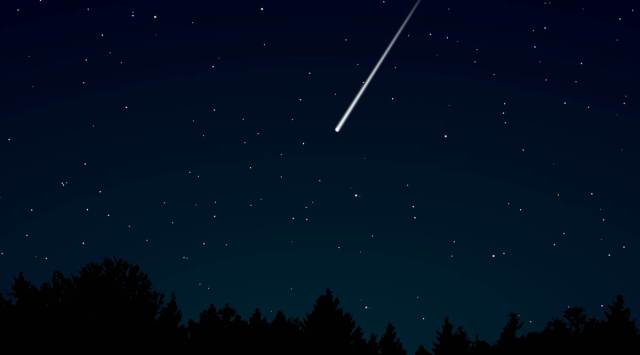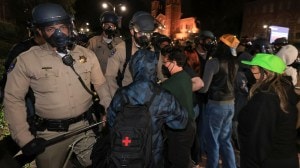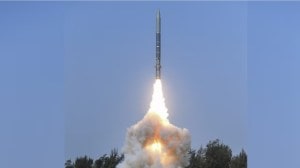- India
- International
A science teacher explains: A shooting star has nothing to do with a star
Shooting stars do have a nomenclature and it might be a little confusing. A meteoroid, meteor and meteorite are the terms used for describing the space debris.
 A popular belief is that wishing on a falling star, makes the wish come true. (Photo: Pixabay)
A popular belief is that wishing on a falling star, makes the wish come true. (Photo: Pixabay)By Rachna Arora
The Lonar Lake crater, located in Buldhana district near Aurangabad, Maharashtra is a geological landmark and a perfect example encompassing history, mystery and science. It is believed to be formed about 35,000 – 50,000 years ago when a rock from space crashed onto the Earth. The lake also finds mention in the Indian epic Ramayana. The lake is a footprint left behind by the collision of a shooting star or more precisely, a space rock with the Earth’s surface.
Stars are burning balls of gas, very far and much larger than the Earth. A rock from space that has entered the Earth’s atmosphere is popularly known as a shooting or falling star.
Alien rocks visiting the Earth are not a rare phenomenon. In fact, nearly 100 tons of interplanetary debris; rock, ice or metal travel towards our planet every day. Usually the debris is the size of grains of rice or pebbles but sometimes they may be as large as boulders. As the debris race through the Earth’s atmosphere, this generates vast amounts of heat which vaporises and illuminates them as they fall, creating streaks of light in the sky, popularly known as shooting stars.

While most debris dissipates into the atmosphere, the big ones display a spectacular light show and very rarely, large sized debris actually reaches the surface of the earth, causing devastation and forming craters. Shooting stars are thus anything but a star, but they do inspire the same awe and admiration as they zip across the sky, a fiery dot leaving a long glowing trail behind it.
The shooting stars do have a nomenclature and it might be a little confusing. A meteoroid, meteor and meteorite are the terms used for describing the space debris. The solid stuff coming from space is called a meteoroid. The phenomenon of the meteoroid getting hot and blazing across the sky as a falling star is called a meteor. Very rarely is an incoming meteoroid large enough to survive all the way to the ground, known as a meteorite.
Meteoroids are matter left behind by comets, asteroids or from the formation of the solar system and also orbit the sun as they are a part of the solar family. If their orbit intersects with that of the earth, due to gravity they start their descent at very high speeds becoming meteors.
At times, the earth passes through a whole cloud of dust, which is primarily left behind by comets or by the collision of asteroids. When this happens we get meteor showers, dozens or even hundreds of meteors per hour, making it one of the most awaited events for astronomy enthusiasts. The point in the sky where the meteors come from is called the radiant and the shower is named after the constellation the radiant is in. As the earth hits a specific comet stream at around the same time every year, the showers are annual. So we have the Perseid meteor shower in August every year and Geminds meteor showers, which are visible in December.
Although pollution in the cities makes it difficult to observe the wonders in the sky, the meteors can be seen after midnight.
Discussion on meteorites will be incomplete without the mention of dinosaurs. The giant reptiles were possibly wiped out when a meteorite smashed into the shallow waters of the Gulf of Mexico. The destructive power of the impact was more than a billion times the power of the atomic bombs dropped on Hiroshima and Nagasaki, and the earth was never the same again.
On February 15, 2013 the world was jolted and reminded again of the devastating power of the meteorites when a rock about 19 m moved across the skies in Chelyabinsk in Russia. Although it exploded into hundreds of small pieces due to the pressure of earth’s atmosphere, which rained down, injuring thousands of people, no big fragments landed on earth. (The meteorite that formed the Lonar Lake was about 1 km in diameter as it slammed into the earth’s surface.)
Scientists and researchers study meteors not only to unlock the mysteries of the universe but are also engaged in developing solutions for mitigating a disaster if a large enough meteoroid cruises near the earth. The idea of ramming a space probe into an approaching meteoroid to change its orbit to avoid collision with the Earth seems straight out of science fiction but is the best possible option for saving the planet in such an event.
The moon too is constantly bombarded by meteorites, which invariably have spawned the vast number of craters on its surface. The meteorites crash onto its surface and do not put up an impressive light show as there is no atmosphere to interact with.
A popular belief is that wishing on a falling star, makes the wish come true. As witnessing a meteor is a rare event and many other rare events too are associated with good luck, it has probably given birth to this superstition. Surely a rock, which has been drifting through space for billions of years, cannot grant wishes!
Meteors are a reminder of our place in the beautiful and dynamic cosmic ecosystem. Probably, dangers to life on earth are not from extra-terrestrial invaders but from large enough rocks spectacularly blazing like a star to fall towards the earth.
(The writer is PGT- Physics at Shiv Nadar School, Noida)
May 02: Latest News
- 01
- 02
- 03
- 04
- 05







































